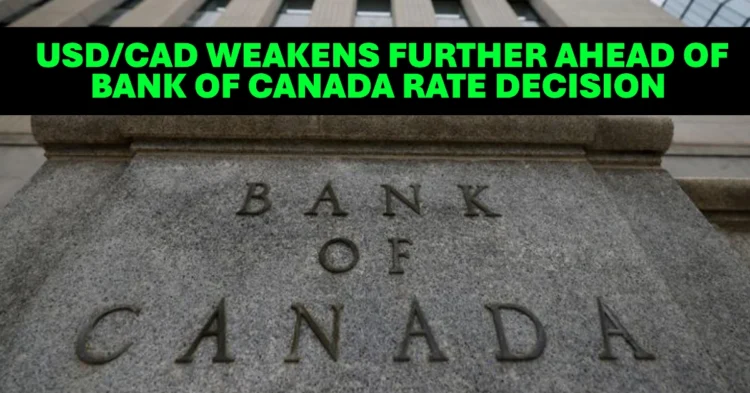Over the past week, the USD/CAD currency pair has declined nearly 1.5%, reflecting a broader trend of Canadian dollar strength. This movement has been fueled by rising expectations around the Bank of Canada’s (BoC) next interest rate decision and continued weakness in the U.S. dollar.
With inflation in Canada showing signs of a rebound and the U.S. dollar under pressure from geopolitical and economic uncertainty, the downtrend in USD/CAD may have further to go in the short term.
Table of Contents
Is the Canadian Dollar Gaining Back Its Edge?
Stronger Canadian Inflation Alters Market Expectations
Canada’s latest inflation report, specifically the year-over-year trimmed CPI for April, came in hotter than anticipated. While markets expected a 2.8% increase, the actual figure reached 3.1%. This unexpectedly high reading has shifted market sentiment and is now influencing monetary policy forecasts.
As of now, traders are pricing in a 71% chance that the BoC will keep its policy rate steady at 2.75% at the upcoming June 4 meeting. Only a 29% probability is being assigned to a potential rate cut to 2.5%. This change in outlook suggests the central bank may adopt a more neutral stance rather than continuing with rate cuts.
Stability Attracts Investment Into the Loonie
With inflation still elevated, a hold on interest rates could bolster the appeal of Canadian fixed-income investments. This development could attract more capital flows into Canadian-dollar-denominated assets, adding further downside pressure on USD/CAD.
Still, it’s worth noting that the Federal Reserve’s benchmark rate remains significantly higher at 4.5%. This interest rate gap may eventually drive renewed demand for the U.S. dollar—especially if global risk sentiment improves and investors seek higher returns.
Why Is the U.S. Dollar Losing Momentum?
Trade Uncertainty Adds to Dollar’s Decline
A key driver of the U.S. dollar’s recent softness has been escalating geopolitical tensions. Notably, former President Trump’s warnings of potential 50% tariffs on European imports have unsettled global markets, decreasing demand for U.S. assets.
This has been reflected in the DXY Index, which measures the dollar’s strength against a basket of major currencies. The index has slipped below the critical 100-point level, highlighting a broader bearish trend that’s weighing on USD/CAD.
Flight to Alternatives Like the Canadian Dollar
As capital exits the U.S. dollar, investors are temporarily turning to other options—particularly those with relatively stable outlooks like the Canadian dollar. While this trend may not be permanent, it is contributing to ongoing weakness in USD/CAD for now.
Bank of Canada Poised for June Rate Cut After April Jobs Shock and Rising Unemployment
What Mark Carney’s Victory Means for Future Bank of Interest Rate Cuts
Technical Analysis: Where Is USD/CAD Headed Next?
Bearish Momentum Dominates
Since March 11, USD/CAD has been entrenched in a firm downtrend. There have been few, if any, significant bullish reversals, confirming the strength of the bearish pressure.
RSI Shows a Bullish Divergence
Despite the downtrend, a bullish divergence is forming in the Relative Strength Index (RSI). While the pair’s price has been setting new lows, the RSI is forming higher lows. This often points to a potential shift in momentum and suggests that the pair may be oversold in the short term.
MACD Suggests Possible Consolidation
The MACD histogram has dipped back into negative territory but remains close to the zero line. This indicates bearish momentum remains—but may be fading—implying that USD/CAD could consolidate before deciding on its next direction.
Key Technical Levels to Watch
- 1.40085 – Long-Term Resistance: This area corresponds with the 200-period simple moving average and could act as a major ceiling for any bullish rebound.
- 1.38048 – Near-Term Resistance: A recent zone of price indecision that may limit upward corrections in the short term.
- 1.36162 – Critical Support: A level first established in September 2024. A confirmed breakdown below this zone could open the door for further downside in USD/CAD.
Conclusion: A Turning Point for USD/CAD?
The recent combination of stronger Canadian inflation and a weakening U.S. dollar is creating a potent backdrop for USD/CAD’s ongoing decline. If inflation pressures keep the BoC from cutting rates and geopolitical risks continue to erode the greenback’s appeal, the Canadian dollar may remain supported.
However, with the Fed’s rate still relatively high and technical signals hinting at a potential short-term rebound, traders should watch closely for signs of consolidation or reversal. The June 4 BoC meeting will be critical in shaping USD/CAD’s next move.

